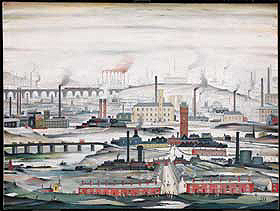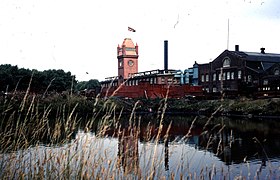
John Constable was an English landscape painter in the Romantic tradition. Born in Suffolk, he is known principally for revolutionising the genre of landscape painting with his pictures of Dedham Vale, the area surrounding his home – now known as "Constable Country" – which he invested with an intensity of affection. "I should paint my own places best", he wrote to his friend John Fisher in 1821, "painting is but another word for feeling".

Laurence Stephen Lowry was an English artist. His drawings and paintings mainly depict Pendlebury, Greater Manchester as well as Salford and its vicinity.

Precisionism was a modernist art movement that emerged in the United States after World War I. Influenced by Cubism, Purism, and Futurism, Precisionist artists reduced subjects to their essential geometric shapes, eliminated detail, and often used planes of light to create a sense of crisp focus and suggest the sleekness and sheen of machine forms. At the height of its popularity during the 1920s and early 1930s, Precisionism celebrated the new American landscape of skyscrapers, bridges, and factories in a form that has also been called "Cubist-Realism." The term "Precisionism" was first coined in the mid-1920s, possibly by Museum of Modern Art director Alfred H. Barr although according to Amy Dempsey the term "Precisionism" was coined by Charles Sheeler. Painters working in this style were also known as the "Immaculates", which was the more commonly used term at the time. The stiffness of both art-historical labels suggests the difficulties contemporary critics had in attempting to characterize these artists.
Graham Vivian Sutherland was a prolific English artist. Notable for his paintings of abstract landscapes and for his portraits of public figures, Sutherland also worked in other media, including printmaking, tapestry and glass design.

Pendlebury is a town in the City of Salford, Greater Manchester, England. The population at the 2011 Census was 13,069. It lies 4 miles (6 km) north-west of Manchester, 3 miles (5 km) north-west of Salford and 6 miles (10 km) south-east of Bolton.

The Lowry is a theatre and gallery complex at Salford Quays, Salford, Greater Manchester, England. It is named after the early 20th-century painter L. S. Lowry, known for his paintings of industrial scenes in North West England. The complex opened on 28 April 2000 and was officially opened on 12 October 2000 by Queen Elizabeth II.
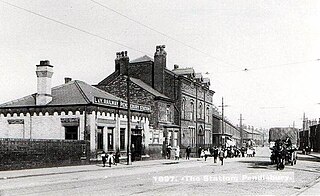
Pendlebury railway station was a station serving the town of Pendlebury in the City of Salford, Greater Manchester, England. It was closed in 1960 by British Railways.
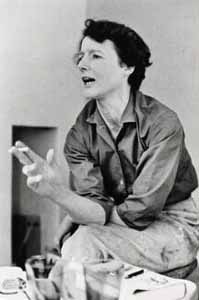
Prunella Clough was a prominent British artist. She is known mostly for her paintings, though she also made prints and created assemblages of collected objects. She was awarded the Jerwood Prize for painting, and received a retrospective exhibition at Tate Britain.

"Matchstalk Men and Matchstalk Cats and Dogs (Lowry's Song)" is a folk song by English duo Brian and Michael. It was released as their first single in late 1977 on Pye Records, and is from their 1978 debut album, The Matchstalk Men. The song reached number one on the UK Singles Chart for 3 weeks in April 1978. As the song is their only major hit, the duo remain as one-hit wonders in the UK, although one more single titled "Mama" briefly made the UK charts at No. 93 in 1983.
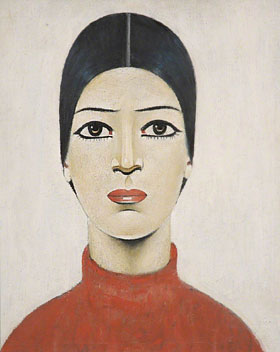
Portrait of Ann (1957) is a painting by British artist L. S. Lowry (1887–1976). Opinion remains divided as to the identity of the subject, who appears in many of Lowry's works, and her significance for the artist.
Trevor Grimshaw (1947–2001) was an English artist whose main subject is the northern industrial town landscape as it used to be.
William Ralph Turner was a painter from Manchester.

Pegwell Bay, Kent – a Recollection of October 5th 1858 is an oil-on-canvas painting by British artist William Dyce, depicting the landscape at Pegwell Bay, on the east coast of Kent. Considered a Pre-Raphaelite work, Dyce employs a mode of heightened realism and intricate detail to create a powerful landscape. It is considered to be Dyce's best painting, and is held by the Tate Gallery.

Coming from the Mill is an oil-on-canvas painting created in 1930 by British painter Laurence Stephen Lowry.

Myles Francis Martin Murphy was an English painter known for his mathematical approach to depictions of the human figure which he learned at the Slade School of Art where he later taught. In 1954 he was seriously burned while painting himself in a wedding dress but subsequently won the Slade diploma prize for the portrait he was working on at the time. In 1974, he won the John Moores Painting Prize for Figure with Yellow Foreground.
Emmanuel Levy (1900–1986) was a Manchester painter, teacher and art critic.
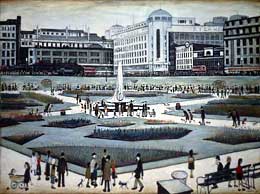
Piccadilly Gardens is a 1954 oil painting by the English artist L. S. Lowry. It depicts Piccadilly Gardens, a large garden square in Manchester city centre, north-west England. The painting hangs in the Manchester Art Gallery on nearby Mosley Street.
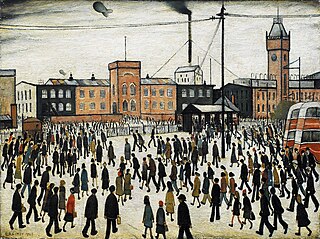
Going to Work is a 1943 oil painting by the English artist L. S. Lowry.
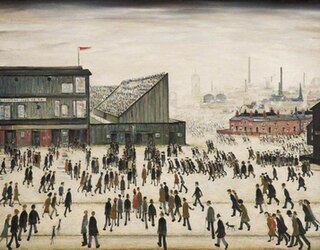
Going to the Match is the title of a number of paintings by British painter L. S. Lowry, depicting crowds of spectators walking towards a sports ground. Lowry's best known Going to the Match painting is his 1953 painting of football fans heading towards Burnden Park, the then home of Bolton Wanderers Football Club. Two earlier works of this title also exist; a 1928 painting depicting fans outside a rugby ground, and a 1946 painting of a crowd of sports fans.
